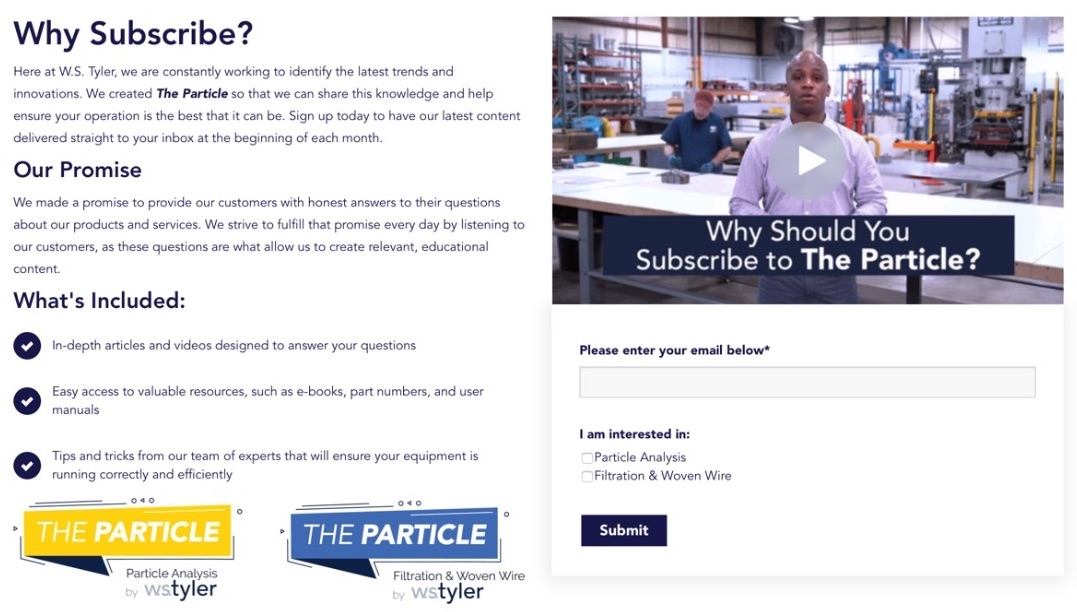Subscribe now and get the latest podcast releases delivered straight to your inbox.
17 Examples of Inbound Marketing That Drive Sales

Oct 11, 2021

These inbound marketing examples include:
- Blog articles
- Videos
- Web design
- Email campaigns
- Self-service tools
- Conversational marketing tools
Whether you’ve been creating inbound marketing content for a while or are just getting started, it’s always helpful to see how businesses like yours are crushing their inbound marketing game.
Regardless of your reason for seeking inbound marketing inspiration — and no matter what your company does, the industry it serves, or whether it’s B2B or B2C — you will find lots of examples here you can use.
In this article, we’re diving into a range of examples that have been created by companies that are successfully using inbound marketing to drive sales so you can use them as inspiration for your own strategy. We’re talking high-performing, revenue-generating content, web design, and tools that have helped these clients of ours grow exponentially by attracting traffic, capturing leads, and driving sales.
Many of these businesses are generating millions in revenue with inbound sales and growing faster than they thought possible — and what they’re doing is far too helpful not to share.
These examples also represent types of content that most businesses aren’t creating (or aren’t willing to, at least).
Ready to get inspired?
Here are 17 examples of inbound marketing done right.
Inbound marketing blog article examples
When it comes to blogging, there are topics you should write about first that drive far better traffic, leads, and sales, yet most businesses aren’t willing to address them. These topics directly align with the questions customers are asking, both in search engines and in sales conversations, but they can sometimes be uncomfortable for businesses to answer — yet doing so is imperative.
We call them The Big 5:
- Pricing and cost: How much your solution costs (including variable factors, considerations, what defines value, etc.).
- Problems: The negatives about (or issues with) your solution that buyers ask about.
- Versus and comparisons: How your product or solution compares to other options in the marketplace.
- Reviews: Honest and unbiased opinions and observations about your product or service.
- Best in class: What the best solution available is.
These are the things that potential customers are curious about.
These are also the blog posts and learning center articles that form the core of your search engine optimization strategy and can be shared on social media to help your company establish thought leadership in its marketplace.
Here are examples of each.
1. Pricing and cost: What Is the Cost of an Overhead Crane System?
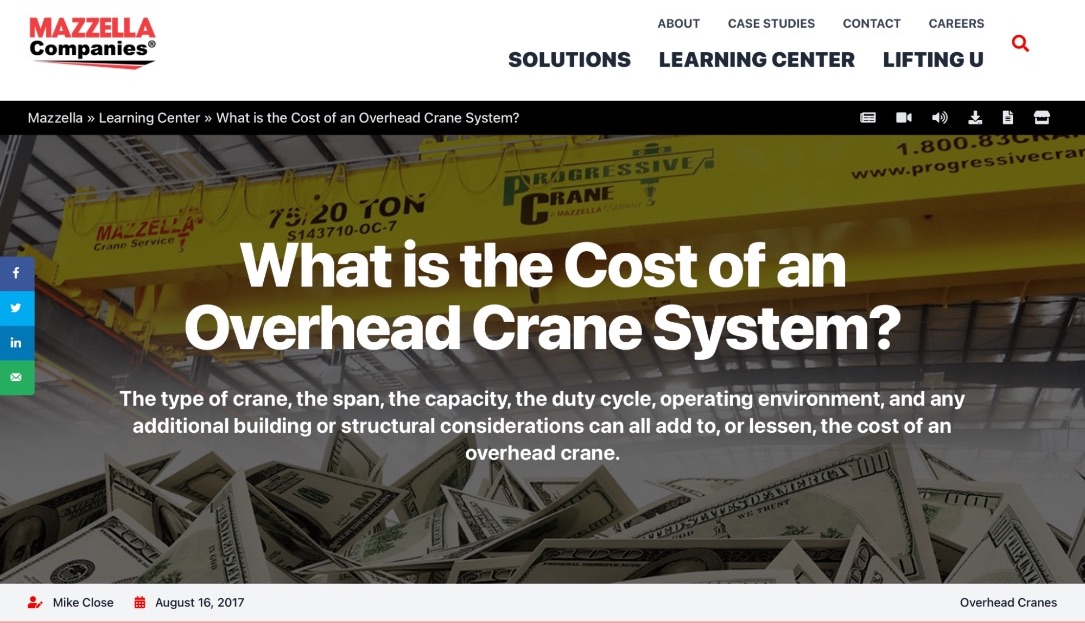
This article by IMPACT client Mazzella Companies is the perfect example of how to approach an often touchy subject for businesses: cost.
Although cost and pricing is something most businesses shy away from talking about openly, it’s articles like these that have helped Mazzella see a $20 million growth in revenue.
Why this example works:
- Even though the cost of the products depend on several factors, the author takes the time to explain what those factors are. Electrical needs, runway length, and installation requirements all need to be considered in quoting a price. Now, when prospects ask for a quote, they understand exactly what goes into that cost.
- The author gives ballpark figures and ranges toward the end. While they can’t give the reader a definitive price, they take the time to explain what the costs might be without leaving the reader hanging. The article promises information about cost, and it fulfills that promise.
- Lines such as “At Mazzella, we have over 50 years of experience quoting, designing, and installing overhead crane projects for customers in all types of industries” help prospects see the company knows what it's talking about. Right away, they establish authority and win your trust.
2. Problems: Top 5 Fiberglass Pool Problems and Solutions
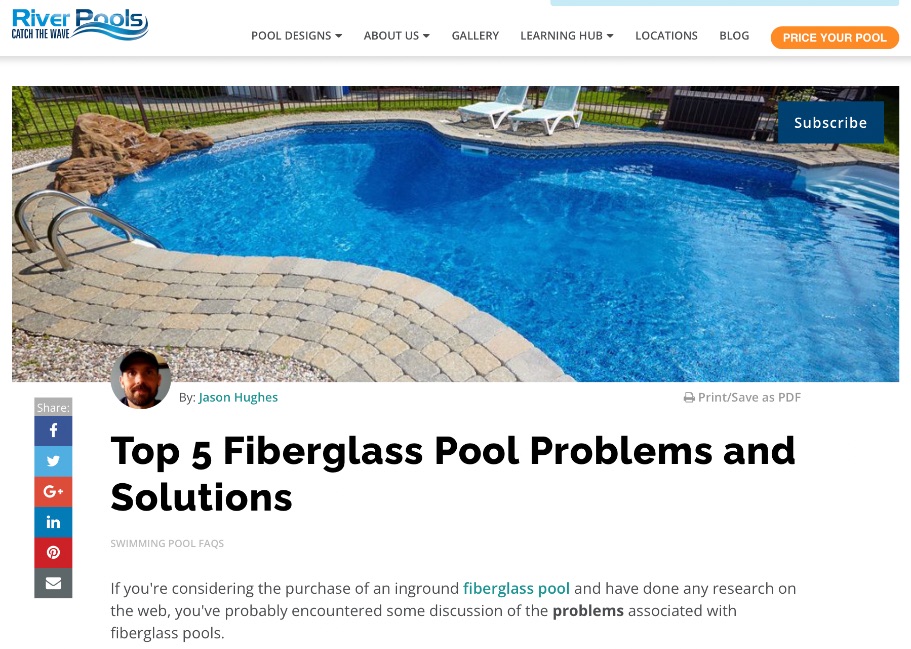
Every business has questions people ask on sales calls that you wish they wouldn’t. These mostly revolve around problems or issues your prospects might have if they buy your product. We all want to believe our businesses have the best solutions possible, but it's likely that our products do have flaws.
The trick to building trust is not pretending these issues don’t exist, but addressing these difficult questions head-on.
Why this example works:
- This article by Jason Hughes of River Pools answers some of the most difficult questions they get asked about the possible faults with their products. (Is it hard to match colors when fixing a fiberglass pool? Do fiberglass pools crack over time? Will my fiberglass pool bulge?)
- Jason not only explains the issues people might have with his compay's products, but he also educates their prospects on the solutions.
When we are willing to address the problems our buyers might experience, we explain the elephant in the room before it becomes a concern, and our customers appreciate the transparency.
3. Versus and comparisons: What Is the Best Insulation for an Attic?
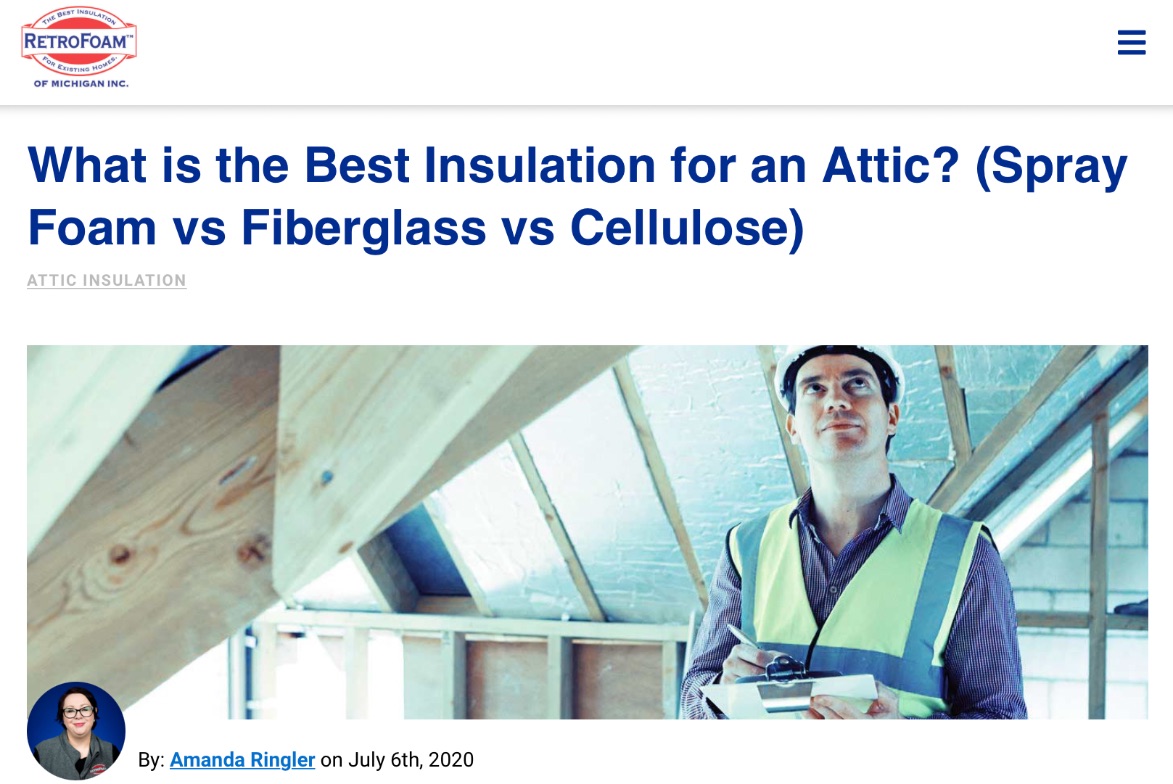
How many times have your prospects asked, “If you were me, which would you choose?”
We get that question all the time.
Yet, despite our prospects wanting to know how our goods and services compare to our competitors’, we won’t talk about them because we think that if we don’t talk about them, our prospects won’t know other options exist.
RetroFoam of Michigan nails it in this article that talks about the differences between spray foam, fiberglass, and cellulose insulation.
Why this example works:
- The article goes through all the pros and cons of each as honestly and thoroughly as possible so prospects feel like they have control over their buying decisions.
- Instead of a hard sell at the end of the article, we get this: We’ve given you all the information you need to make your decision, and the best choice is whichever is right for you — even if it’s not our product.
At the end of the day, people want to know how your products and services compare to other options, so we need to talk about them. Even if it means they end up choosing another brand or business.
Showing both sides of the coin makes you appear trustworthy as you demonstrate expertise.
4. Reviews and best in class: Best Commercial Real Estate Companies in Austin, Texas

As buyers and consumers, we also love to search for reviews and the best in class. This is because as long as we can compare our options and see what everyone else says, we can make more informed decisions about what we buy.
Writing an article titled “Best Commercial Real Estate Companies in Austin, Texas” if you’re a real estate company in Austin, Texas, might not sound like a good idea. But Aquila Commercial didn’t shy away from it, and neither should you.
Articles like these not only build more trust with your prospects, they also help you rank for searches for your competitors!
Why this example works:
- The real estate company drew up a list of its competitors and discussed who each of them is and what they do without including itself on the list. (If you create a “best of” list, your prospects will know you wrote it, and if you put your own business on it, you appear biased and you lose credibility.)
- They never talk badly about their competitors, but they also keep the conversation matter of fact.
- They explain that, though they know they can help with the prospects’ needs, they also know there are other options out there. This makes your potential customers feel like you value their needs over your own, and who wouldn’t trust a company that does?
For more information on how to create this valuable content, watch our free course How to Write “The Big 5”.
Also, set up an appointment to talk to an advisor here at IMPACT. We’ve taught hundreds of businesses like yours how to write these articles, and we can answer any questions you have.
🔍 Related: 5 Key Elements of a Winning Inbound Marketing Strategy
Inbound marketing video examples
For businesses using video in their marketing campaigns, you need to know which videos are the most effective so your investment helps your company grow and doesn’t drain its resources.
Here at IMPACT, we teach our clients how to create seven highly effective video types that build trust with your prospects and skyrocket your sales. Each of these inbound marketing videos can be used by your sales team to improve its process.
We call them The Selling 7:
- The 80% video
- Bio videos for email signatures
- Product and service fit videos
- Landing page videos
- Pricing and cost videos
- Customer journey videos
- “Claims we make” videos
The examples below represent each of these video types so you can create them on your own.
5. The 80% video: Buying a Metal Roof? Top 9 Things to Consider
If you ask your sales team how often they get asked the same questions over and over again, chances are they’ll tell you around 80% of the time.
Instead of your sales team answering these same questions during each sales call, you can create these 80% videos that answer these questions in advance.
An example of one of these videos comes to us from IMPACT client Sheffield Metals, where they go over nine things you need to know before buying a metal roof.
Why this example works:
- It goes over common questions buyers ask, such as cost, quality, and comparisons.
- It covers a range of product and service information, strung together as one video.
- In the video description, they list what the video covers so prospects can skip to relevant information.
- They include a link to a buying guide so that if the prospect is interested, they know where to go next.
Imagine how useful sending a video like this prior to a sales call would be for your sales team.
6. Bio videos for email signatures: Get to Know Leigh Ellis, AQUILA Principal
Bio videos are powerful tools for humanizing your business because they allow prospects to “meet” and see your sales team before they interact with them one-on-one.
Aquila makes our list again with this powerful bio video introducing one of its principals, Leigh Ellis.
Why this example works:
- The video explains what Leigh does for the company.
- It also shares what he loves about his job, revealing a small bit of personal information about what he does outside of work to give the prospects a feel of who they will be working with.
- This short video can be placed in an email signature.
Videos like this get an average of 25 to 30 additional views per month, not to mention more prospects who know your name, face, and story, often before you even reach out to them.
7. Product and service fit videos: Should You Buy Moveable Walls?
Most businesses love to talk about how their products and services are so wonderful, but few discuss one very effective thing: who their products and services are not a good fit for.
The moment we address this, we eliminate bad-fit prospects we would otherwise be wasting our time with. We also become more attractive to our right-fit customers.
After training with IMPACT on how to do these videos correctly, Office Interiors nailed it in this product and service fit video about moveable walls.
Why this example works:
- The video starts by educating inbound sales prospects about what the product is and how it works.
- It discusses benefits and drawbacks.
- It goes over cost and everything the buyer needs to make a decision.
- They also cover who should not buy moveable walls.
Videos like these help weed out your bad-fit leads, thus saving your sales team time they otherwise would have wasted. They also help strengthen your appeal to good-fit leads by, again, building trust.
8. Landing page videos: Should I fill out this form?
Landing pages are any page on your website that offers a form for prospects to fill out. It might be something like “sign up for our newsletter” or “download our free guide.”
When consumers land on these pages, most don’t want to give up their personal information for fear they will be overwhelmed with spam or that the form will take too long to complete.
A landing page video helps eliminate these fears by walking prospects through exactly what they can expect when they fill out the form, like River Pools does on their pricing page.
Why this example works:
- The video is embedded directly next to the form with a title that clearly states its purpose: “Should I fill out this form?”
- It goes over what to expect. (You won’t get spammed, but you’ll open a line of communication with one of our reps. You will also get an email and a phone call.)
- It reassures prospects there’s no obligation created by filling out the form.
These videos have helped many of our IMPACT clients get an 80% increase in form submissions, which generated hundreds of thousands of dollars in revenue.
9. Cost and pricing videos: How Much Does a New Roof Cost?
You can address the subject of cost in video as well.
Even if your costs depend on several factors, you should talk about those factors and how they drive your costs up and down, just like Bill Ragan Roofing did in their video “How much does a roof cost?”
Why this works:
- The video breaks down everything the prospect needs to get a ballpark figure of how much their rook might cost (square footage, complexity, material, etc.).
- It covers all the angles and helps people calculate their costs without promising a finite number.
These videos give your prospects an efficient way to share cost information with key decision-makers. This can help overcome any communication gaps that might otherwise happen if important information goes through too many others.
10. Customer journey videos: Real Interior Design Stories | Linda in Charleston, SC
While most businesses know to provide client testimonials or case studies on their websites, few companies describe the customer journey.
These are three-stage videos that use the traditional hero’s journey to explain the prospect’s problem, share the journey they took to fix the problem, and describe where they are today, which shows that with your help they were able to fix the problem.
After working with IMPACT, La-Z-Boy Home Furnishings & Décor created a customer journey video that does all this and more.
Why this example works:
- It showcases the warm relationship between the customer and the saleswoman.
- The video shows part of the decorating process and the big reveal for the client.
- It’s a feel-good story that other prospects can see themselves experiencing.
Customer journey videos help prospects feel more comfortable working with you — which is what all small businesses should try to do.
11. “Claims we make” videos: Behind-the-Scenes of Industrial Thread & Yarn Factory
“Claims we make” videos provide your prospects with proof that you are what you say you are. These are typically the things we tell our prospects, such as:
- We are the best at _______.
- We have the most _______.
- No one does _______ like we do.
Any business can make these claims, but the most successful ones are those that can prove it.
IMPACT client Service Thread does just that with this behind-the-scenes video highlighting who they are as a company.
Why this example works:
- It feels similar to an “about us” video, but provides lots of visual proof the company is who it says it is.
- The information is customer-focused while showcasing Service Thread's employees and team.
- The video utilizes several different people and roles to tell the company story.
In our Pro course, Crafting “The Selling 7” Videos That Convert, you can learn more about how to create these videos with IMPACT Coach Will Schultz (the course is free with a 14-day trial of IMPACT+ Pro).
Inbound marketing web design examples
When buyers find your website, they immediately want to know whether you can solve their problem. To create an effective inbound marketing website, you need to focus on what your prospect needs, not how great your company is, which is what most businesses do.
These website designs show what a useful website should look like.
12. Homepage layout: Acculevel
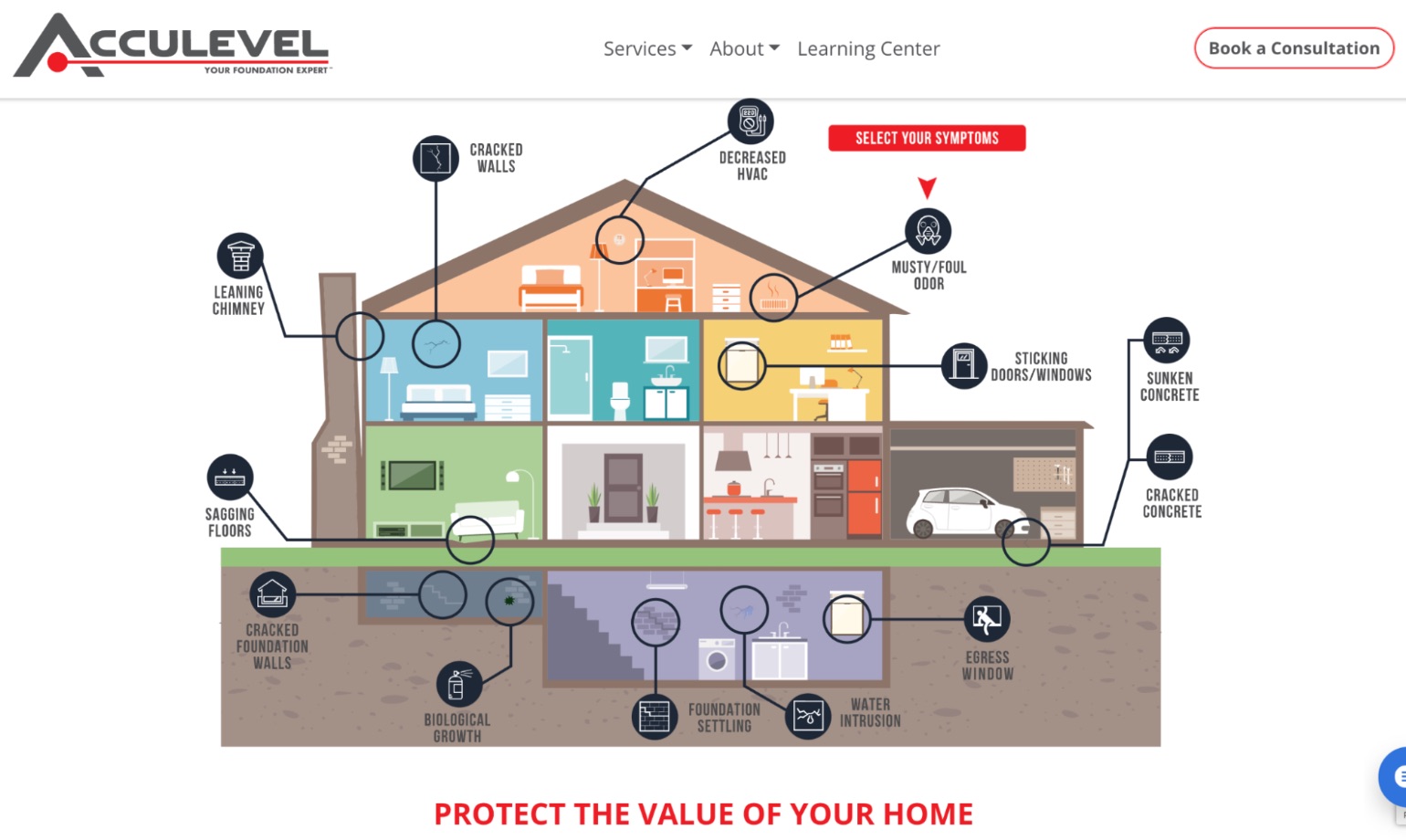
The primary goal for your website’s homepage is not to teach prospects everything you know, but to get your visitor to page two.
This is because if someone lands on your website, all you know is that they found you. But when they navigate to your pricing, products, or services pages, you know much more about what they’re looking for, and your sales team will have a better idea of their needs.
Our client Acculevel has done a great job at getting users to navigate beyond its home page.
Why this example works:
- The homepage avoids large paragraphs or blocks of text.
- It provides clean navigation that shows prospects where to go.
- Prospects immediately see the selection of problems they might be facing and what the business can help them do.
- Each “problem” a prospect selects results in a popup with more information about why that problem is happening and how to solve it.
This website clearly and easily leads prospects through the buyer’s journey, while educating and empowering them to make their decision along the way.
13. Inbound marketing content layout: River Pools
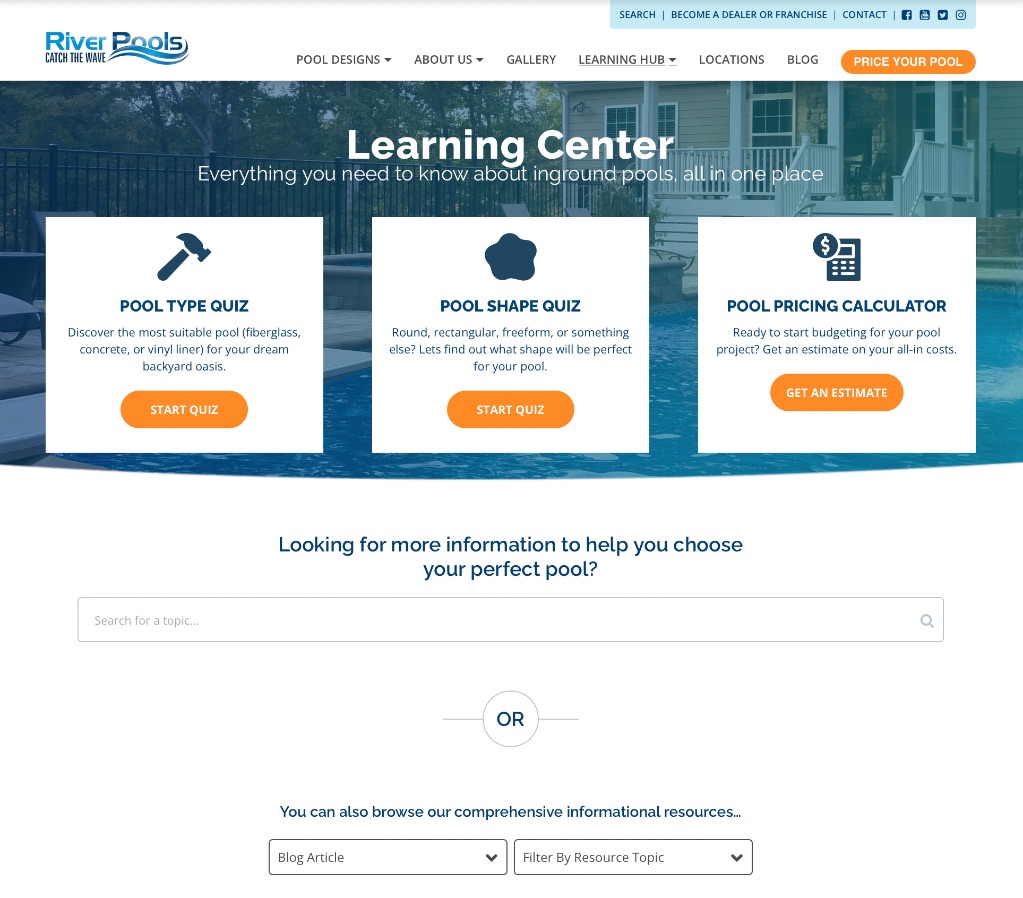
Nearly all of the content on your website, other than your products and services pages, should be educational information that answers all your prospects’ questions and nudges them toward a sale.
Whether you’re creating blog articles, videos, whitepapers, or buying guides, all your content should be kept in a centralized educational space we like to call the “learning center.”
This learning center example comes to us from River Pools, which does this exceptionally well.
Why this example works:
- It features a few engaging self-service tools, such as quizzes and pricing calculators.
- The page provides a search bar and a “topics” dropdown menu so you can search and browse as you please.
- It offers plenty of opportunities for prospects to submit their contact information
All these elements serve to help the prospect find what they’re looking for.
Other inbound marketing examples
Newsletters and email campaigns are a traditional part of inbound marketing methodology that are still relevant. Newer approaches, such as chatbots and self-service tools, are on the rise.
Here is a sample of what some of our most successful clients are doing in these categories.
14. Email marketing: W.S. Tyler
A manufacturer of women’s wire cloth and mesh materials, W.S. Tyler launched a wildly successful “choose your own adventure” style email campaign. Based on their answers to multiple-choice questions, prospects are sent content that is directly related to their choice.
Why this example works:
- It offers an out-of-the-box way to motivate unengaged contacts to take another look at your solutions.
- It personally addresses prospects’ self-identified pain points and challenges.
- It sends relevant content to the right person at the best possible time.
These emails were so effective for W.S. Tyler that they achieved a 74.14% open rate, which is basically unheard of, especially for unengaged contacts.
15. Self-service pricing tool: River Pools’ Pricing Calculator
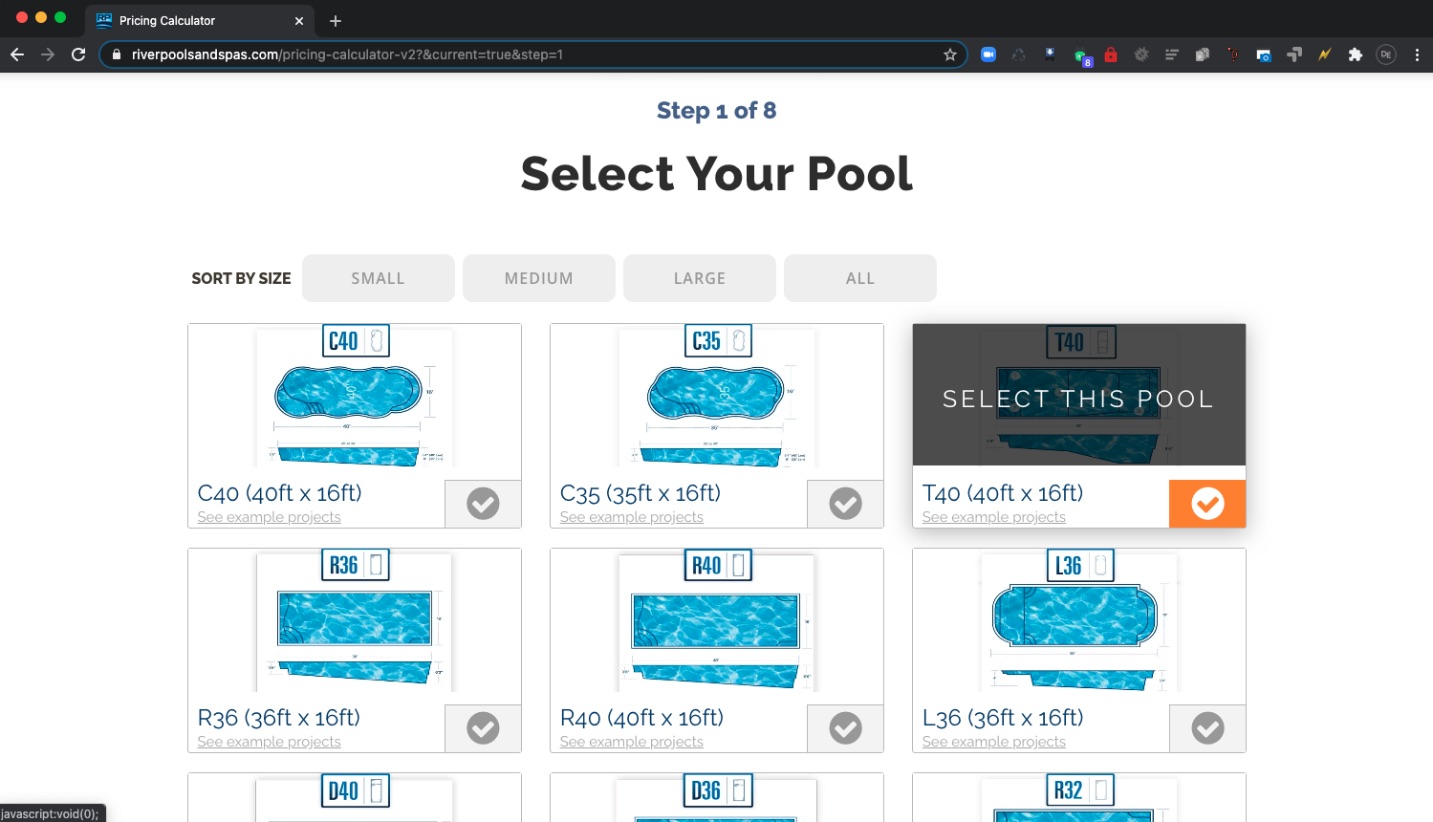
River Pools has an awesome pricing tool to help you find the perfect swimming pool for your backyard.
Why this example works:
- In just a few clicks, you can plan ahead for unanticipated costs that might come with the options and add-ons the company offers.
- It informs prospects about every option, with details educating them about each step they take (what the product is, why you might or might not need it, etc.).
- It allows prospects to select the materials that’ll go into their pool and any add-ons, such as automatic vacuums or cascades.
At the end of the process, after the prospect enters contact info, the quote gets sent off to their mailbox. It’s a quick and easy way to empower buyers to make their own choices.
16. Self-service comparison tool: Rancilio Group
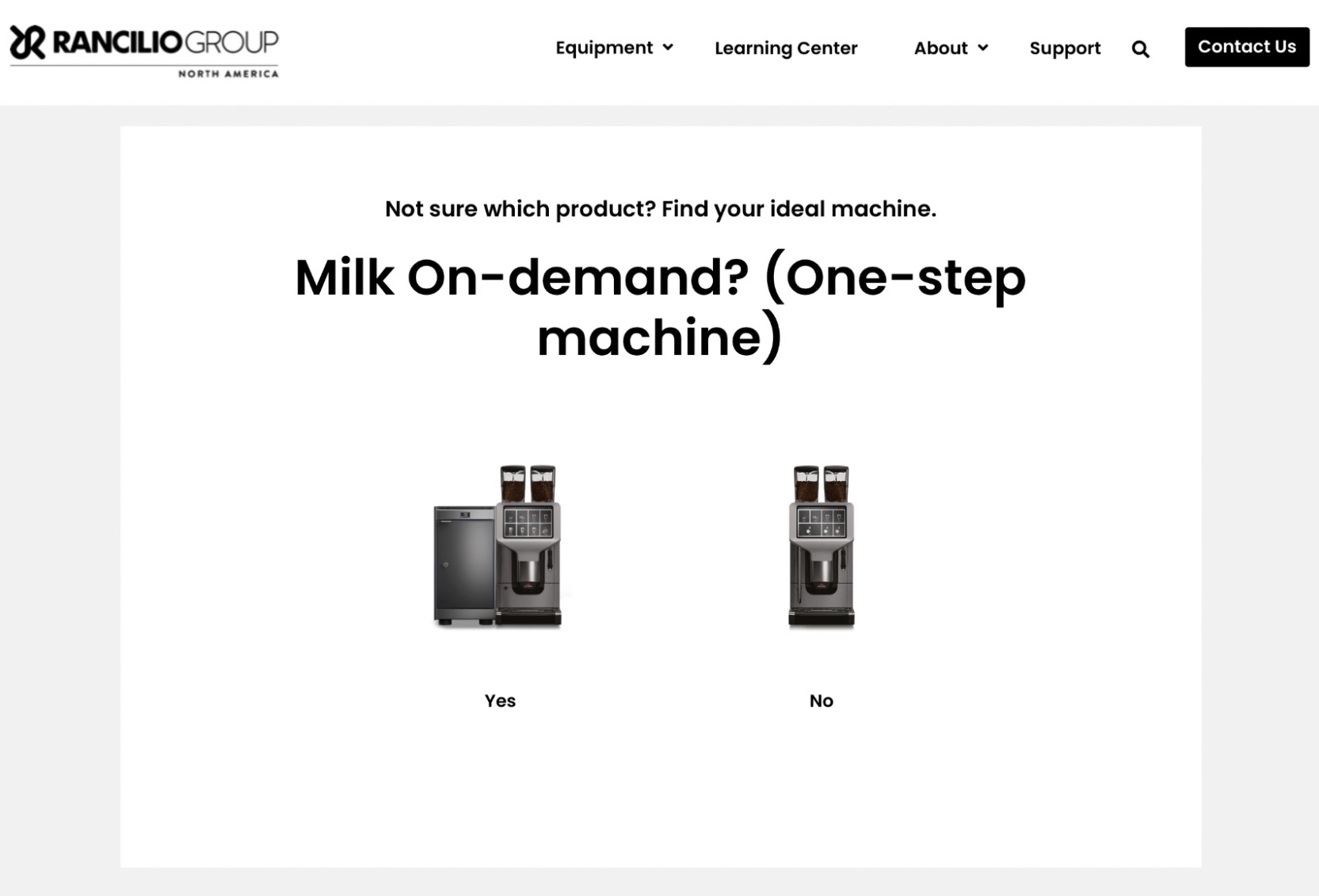
This helpful comparison tool by IMPACT client Rancilio helps prospects select the right coffee machine for them, based on preferences for volume, coffee type, and milk-carrying abilities.
Why this exampleworks:
- It gives prospects who might not know the extent of Rancilio's products an easy, engaging way to shop.
- At any point, a user can get in touch with one of the company’s specialists to answer questions.
- It’s a quick and easy way to learn about the different options available, that also simultaneously guides prospects closer to a buying decision.
With helpful information and ways to get prospects’ questions answered quickly and easily, self-service tools like these create better buyer awareness — which inevitably leads to more sales.
17. Conversational marketing tools: Berry Insurance Chatbot
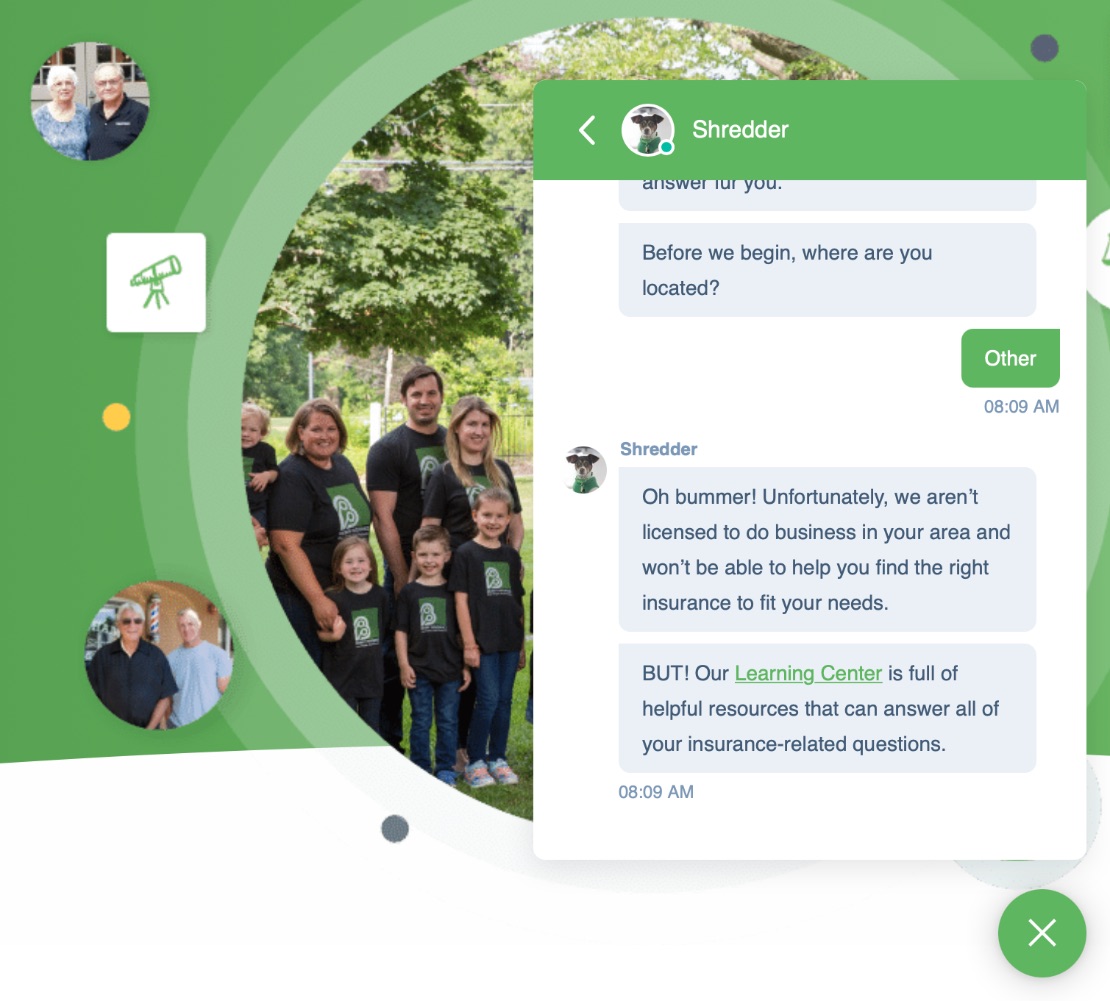
For prospects who want to ask questions on your website without the hassle of searching for your phone number or email address and waiting for a reply, chatbots, live chat, and other conversational tools are the way to go.
IMPACT client Berry Insurance is seeing great success with their fun and unique chatbot featuring the company mascot, “Shredder.”
This approach:
- Helps guide customers through the sales process in a creative way.
- Immediately susses out whether you’re local to them, which eliminates bad-fit leads.
- Offers virtual assistance to bad-fit leads who can still benefit from Berry's learning center.
This is a great example of how to kindly turn away bad-fit leads while also being a helpful, trustworthy business in the process.
Create better, results-driven content for your business
All the examples we share in this article are inspired by a proven inbound marketing framework we teach our clients called They Ask, You Answer.
Here at IMPACT, it is our sole mission to help businesses like yours thrive with all aspects of their inbound marketing journey. This includes helping them get the most out of their content marketing tools and creating inbound marketing content that is the most powerful sales tool it can be.
Hundreds of our IMPACT clients have created sales-driving content using the They Ask, You Answer framework, and you can too.
To take the first step toward implementing They Ask, You Answer in your business and seeing incredible sales results in your company, check out these helpful resources:
- They Ask, You Answer fundamentals with Marcus Sheridan
- Inbound marketing services
- They Ask, You Answer Video Resource Library
Our strategic coaching and hands-on training for your marketing and sales teams will help you improve your marketing metrics and scale your business with a better inbound marketing strategy. Set up a time to talk to one of our advisors, and we’ll show you how to implement these strategies for your business today.


Order Your Copy of Marcus Sheridan's New Book — Endless Customers!
